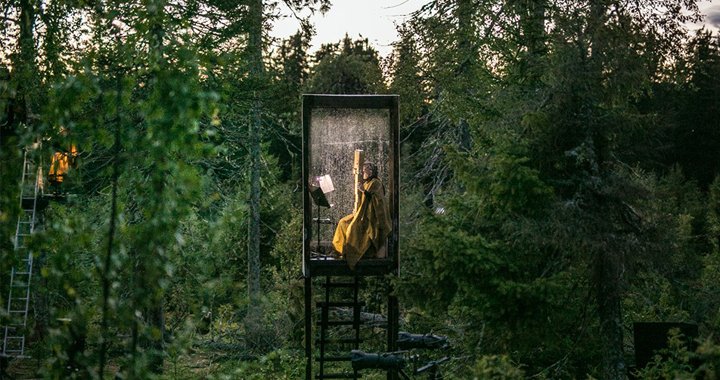
Vectors of willpower meeting in the forest
Regarding the performances of Anna Ķirse’s Tree Opera. Windthrows in the forests of Finland
13/09/2019
Photo: Janne Korkko
On August 17 and 18, the premiere and a repeat performance of composer Anna Ķirse’s Tree Opera. Windthrows took place in a forest near the Mustarinda residency in Finland’s Kainuu region. The tale of this project’s success is a tale of lucky coincidences and sufficient individual and communal will to let something unusual take place. According to Ķirse herself, she was walking through a forest a few years ago when she looked up and saw in her mind’s eye a soprano singing at the top of a tree, and the thought became stuck in her mind.
Willpower made that thought a reality and soon led to Ķirse’s first Tree Opera, produced at the Sansusī Festival in the forests of Susēja, Latvia, in 2016. In 2018, a shorter version of the opera was performed in a small park along Zeļļu Street in the Pārdaugava district of Riga. This year, a collaboration with partners from Finland resulted in the most ambitious stage of this project to date. Ambitious, because the Mustarinda residency stands in the middle of nowhere, a place that people accustomed to civilisation find difficult to even imagine. The nearest village is thirty kilometres away, there are forests as far as the eye can see, the property has no connection to a public water supply, and reaching it involves driving long distances on narrow, hilly dirt roads. It’s said there are lots of bears and other wild animals in the area (although I only saw one reindeer). But because Mustarinda lies at a relatively high elevation, there’s a Finnish telecommunications tower nearby, so at least the Wi-Fi works passably.
But all of that applies only to the modest complex of buildings at the residency. To get to the clearing where Ķirse’s opera was performed, one needed to traverse a relatively difficult forest trail about two kilometres in length. The performances began at 10:30 p.m., and already an hour before start time all 200 or so audience members had formed a long line behind their guide and begun the slow hike to the clearing, which led to the fainting and hospitalisation of at least one person. A plethora of cameras, cables, soundboards, speakers, microphones, instruments, ladders, platforms, spotlights, generators, music stands, large mirrors and all sorts of other equipment needed to put on a regular opera out of doors awaited them in the spacious forest clearing. Not to mention the ways in which architect Austris Mailītis and artist Andris Eglītis had transformed and adapted the space for human needs at the same time not interfering in the ecosystem of the forest in any excessively brutal way. They used no nails, screws, paint or lacquer in building the permanent stands, stage constructions and audience seating. The wooden structures will decompose back into the forest in around five years or so.
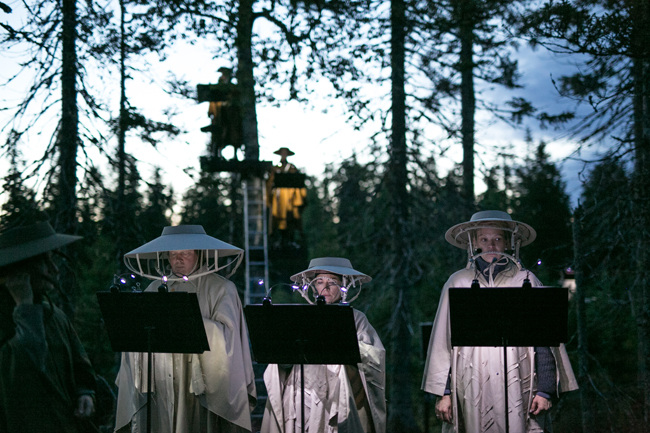
Singers of the Latvian Radio Choir during the opera
In addition to the artistic team involved in creating the opera’s score (Ķirse), libretto (Andris Kalnozols), direction (Matīss Budovskis), architecture (Mailītis), scenography (Eglītis), costumes (Mareunrol’s) and sound engineering (Tālis Timrots) as well as the eleven people in the Finnish-Latvian production troupe, the performance also featured eight soloists from the Latvian Radio Choir and nine orchestra members.
All of this, of course, demanded an impressive amount of communication, logistics and resources, and I got a slightly romantic feeling of joy seeing this dream, which had begun with such a carefree vision, come to fruition. Musing about it later, however, leads to several questions that I believe are worth addressing.
Windthrows is a somewhat curious return of the opera genre to its roots. Before the boom in the construction of grandiose opera houses in Europe’s cities, opera was mainly a courtly genre in which troupes of stage craftsmen entertained kings, aristocrats, nobles, and other people of privilege. Over the centuries, as operas have been performed on the street and in multiple-balcony theatres, on stages and under the open sky, on film and on television, the Mustarinda event once again reminded us of the elitism of this genre, with the audience consisting of a select, chosen group of people. Only here the relationship was reversed: if in 16th-century Italy troupes of artists travelled to royal courts, today the artists selected their own court – a clearing in the forest – to which Finnish pensioners from the surrounding area, friends and family members of Radio Choir singers, music and arts journalists and a few other chosen people travelled. They had arrived to concentrate on the latest contribution to a genre that has over the past five centuries successfully fluctuated between an enjoyable form of entertainment and some of the most ingenious and serious works of art in human history.
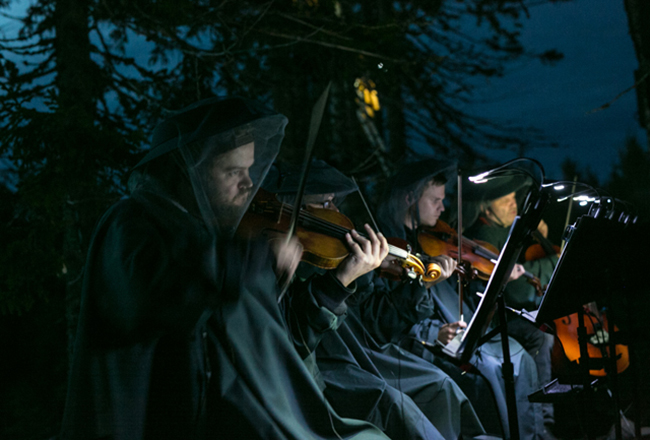
String quartet during opera
And where does Windthrows fall on this spectrum? I will not comment much on what I understand the least, namely, music. Only to say that Ķirse is a talented and original young composer whose creative decisions regarding this or that note are almost always based on the senses. I also felt sensuality permeating Windthrows, even though the lack of melody and the unpredictable nature of the music were at times difficult for an untrained ear to listen to. However, anybody who had read through the short description of the plot beforehand could easily follow along.
What is hard to avoid is the positioning of this mist of ostentatiousness in front of the opera’s content and message. There is a great temptation to enthusiastically admire and appreciate the work and resources invested in this production, the artists’ originality, willpower and faithfulness to the artistic idea, the imagination and ingenuity of the producers, and the technical abilities of the creative team and musicians, all of which did not disappoint in the least. And yet some old-fashioned voice in me insists that no formal excellence and completeness should cause one to forget the content and message of a work, especially if we’re talking about opera. On the other hand, I must admit that the relationship between form and content differs in classic and contemporary opera, and these two aspects cannot even truly be separated in the latter. With Tree Opera, it is no longer a matter of drama narrated sensually and musically, but of a largely non-linguistic experience created with the help of all formal means. And no matter how banal it seems to once again use the term ‘magic’ in relation to this event, I nevertheless want to return to that word to describe the experience.
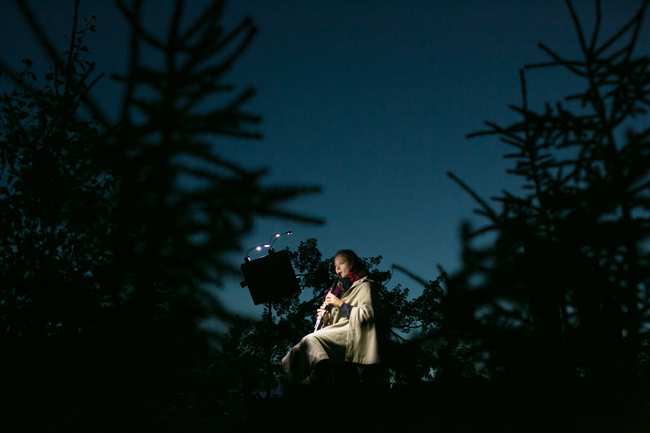
Clarinetist Anna Gāgane during the opera
The magic did not begin with the first notes of the opera; instead, it began quite some time earlier. Maybe not as we climbed on the bus in Riga, but definitely by the time we had begun the meandering hike from the residency to the forest clearing where the opera took place. In a world that science has over centuries of hard work drained of mystery and enchantment, people still wish to experience, even if for just a moment, the feeling that mysterious and unapproachable but very real powers lie behind the things we see, feel and think we understand. A picturesque old forest at dusk is a wonderful place and time to indulge in the craving for this illusion: the still-visible but ever-darkening silhouettes of trees, shrubs, rocks and hillocks may look like gnomes and fauns, or they may hide elves, fairies or more dangerous beings. The speakers hidden in the bushes along the trail to the clearing only add to these fantasies. Someone stands between the fir trees swinging a bullroarer, an ancient musical instrument.
Armed with dim torches, the audience members slowly wind through the forest until they reach the clearing, which is located on a slope and thus forms a natural amphitheatre. Most of the audience takes a seat on the three bleachers, while the remainder sit on tree stumps or on the ground. In the dark, the ghostly old trees damaged by the wind look like the devil’s forks, eerie goblins or ents from Tolkien’s world. The musicians are already standing motionless in their places, under the spotlights and dressed in costumes designed by Mareunrol’s and inspired by beekeeper suits. Some of the singers are standing on a low stage closest to the audience; others stand amidst the foliage of the trees (tenor Kārlis Rūtentāls has been raised to a height of twelve metres with the help of mountaineering equipment). A string quartet sits a little further away; the wind instruments are upstage. Anna Petrini waits in a glass box to the right of the stage with her Paetzold bass recorder.
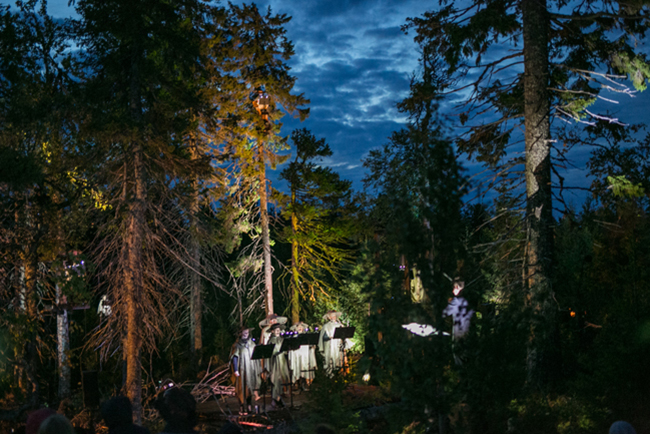
View from "Tree Opera. Windthrows" performance
It takes some time for everyone to take their places. The mirrors placed all around the clearing move in the gentle breeze, causing the reflections from the spotlights to constantly dart around and bring an unpredictability to the glimmering play of shadows and light. I am overcome by the mystical scene, but at the same time lightly irritated by the sound of zippers, whispers, coughs and swishing fabrics that the audience apparently cannot do without. However, when conductor Artūrs Gailis lifts his hands, everyone falls silent and Tree Opera. Windthrows begins with the mushroom choir of women’s voices.
What follows is a forty-minute journey through sometimes melodic, sometimes cacaphonic instrumental, vocal and electronic passages with rapid rhythmic changes that portray a variety of forest voices that have met here to tell their stories. The choice of the composer and librettist to write the opera’s few stanzas in Latin is of particular interest. Did they choose a dead language because some of the protagonists in the work – fallen trees and leaves – are also supposedly dead? Or because this once “universal” language emphasises that the forest is a unified, dynamic organism? The sound system is arranged so that the sounds emanate from where the individual singers and musicians are physically located, thus enhancing the feeling of spatiality. Although it is fascinating to watch, it is good to close your eyes from time to time, knowing that it’s nighttime and you’re deep in the forest, a cool breeze blowing across your insect-repellent-covered face, your ears picking up the voices of the forest enlivened by the composer’s hand. In this state, the anticipated illusion of magic conquers almost everyone, regardless of musical background, and states of consciousness begin to transform in unknown directions.
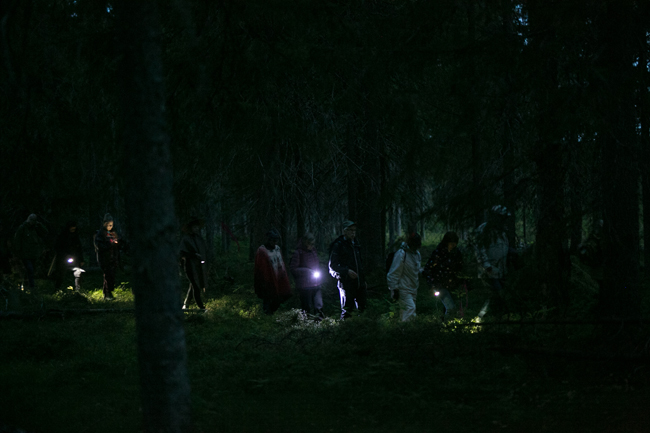
The audience on their way to the show
Another wonderful thing took place on the evening of the premiere: as the last notes faded away, a gentle gust of wind blew across the clearing, and the rustling of the leaves seemed so organically rhythmic that it could well have been included in the score. The combination of all of this created a feeling that will stay with the audience for quite some time to come. The aforementioned ostentatiousness become restrained, content overlapped form – the content with which consciousness filled itself in an associatively creative manner.
Content in the “classic” understanding, of which I wrote above, is content in a much narrower definition – it is the story contained within the opera’s libretto. Even the most contemporary opera is about something and has some kind of meaning beyond the score and performance. Tree Opera. Windthrows works with emotions, associations and fantasies and deliberately leaves the narrative aspect in the background. However, that aspect still exists and deserves attention.
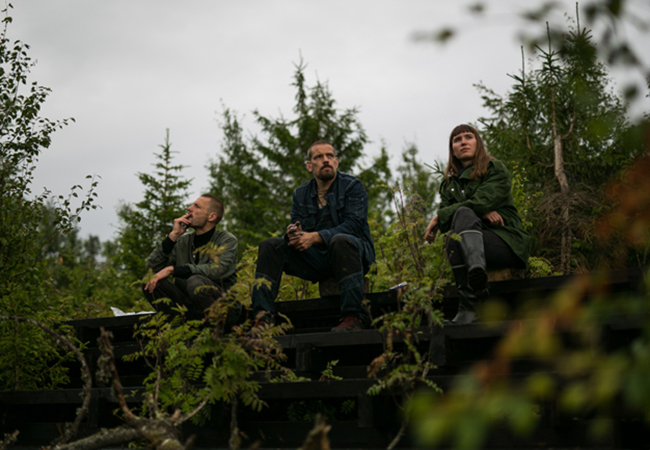
From left: architect Austris Mailītis, artist Andris Eglītis, assistant architect Roberta Fišere
The story is based on a conversation between four levels of the forest: roots (basses), trunks (tenors), branches (altos) and leaves (sopranos). They converse about the time before the storm, about the storm itself and its strength, about the consequences of the storm and, although generalising a bit, the cyclical nature of natural processes. The story is driven by two main idea vectors. I would call one of them the mythically esoteric, perhaps even Tolkien-like, vector in which the forest is conjured as a conscious, diverse and at the same time absolutely unified entity, an organism that operates according to its own internal processes, and each intervention has its consequences. The other one I would call the ethically responsible vector, or the one in which, as they contemplate the ecological, environmental and climate challenges of our time, an increasing number of intellectuals from a variety of disciplines are calling for us to not treat nature as alien, hostile, different, or submissive but instead as something we are a part of. This is also reflected in the clearly evident internal culture at the Mustarinda residency and the stage made entirely of natural materials. If ecological thinking, concern for the future of mankind and the feeling of everything in the world being connected cannot be achieved through rational explanations, perhaps it can be achieved by inviting people to the forest – the same kind of environment that is currently burning out of control in several places around the world – and transforming public awareness through art and myth instead of science.
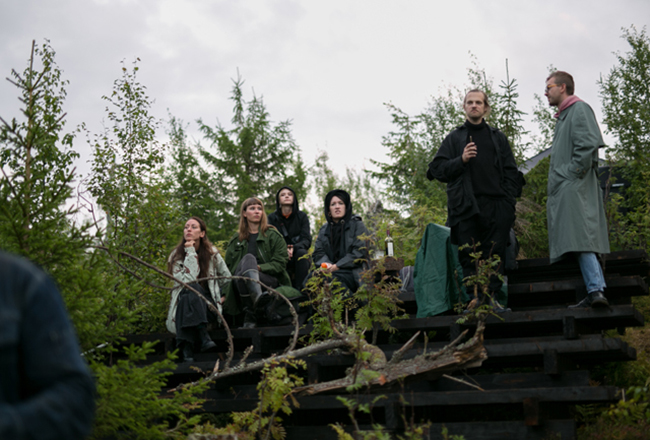
From left: composer Anna Ķirse, assistant architect Roberta Fišere, assistant costume designer Laura Birsa, costume designer Mārīte Mastiņa-Pēterkopa, costume designer Rolands Pēterkops, producer Jānis Laucenieks
The texts accompanying this event mention Peter Wohlleben’s book The Hidden Life of Trees as a literary reference uniting these two vectors. I understand why this work may have seemed related to the opera’s concept, but the texts could easily have done without it, especially because the book makes scientific claims that have been thoroughly called into question. But also because the Tree Opera narrative does not require any additional scientific or pseudoscientific justification – it is already justified well enough by, if you will, the spirit of our times. The re-exploration and romanticising of the mythological stories of ancient societies, most vivid in the fantasy literature of the 20th century, has been a popular form of Western escapism at least since Wagner and Novalis, and the forest (which, admittedly, is a fantastically complex and fantasy-inducing phenomenon even on a purely scientifically descriptive level) plays a central role in that process.
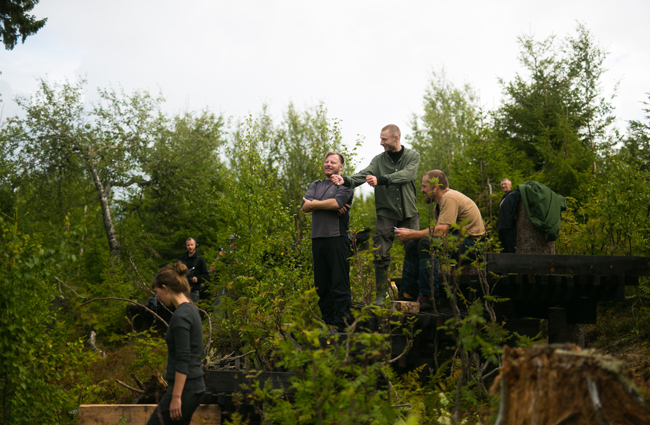
The creative group in process
On the other hand, I have quite clearly experienced efforts to overcome the Anthropocene Epoch and to revise the human-nature relationship even in my own recent practice. Earlier this summer I interviewed Jens Hauser, the curator of the Un/Green exhibition at the RIXC Festival and one of the most innovative minds in the world when it comes to thinking about the relationship between humans and nature in the context of today’s crises. As I sat on the train and crossed into Finland on my way north, I was editing my conversation with curator Rebecca Lamarche-Vadel, whose concept for the next edition of the Riga International Biennial of Contemporary Art (RIBOCA) also centres on a revision of human-nature relations. This vector – defined by necessity, not choice – is clearly “in the air”, and the ethical-intellectual-responsible aspect of Tree Opera is organically attached to it. And the 400 select audience members who ended up in the Mustarinda forest to see the opera in person felt these ideas on their own skin, even if the initial magic of the experience did not yet allow them to identify those ideas.
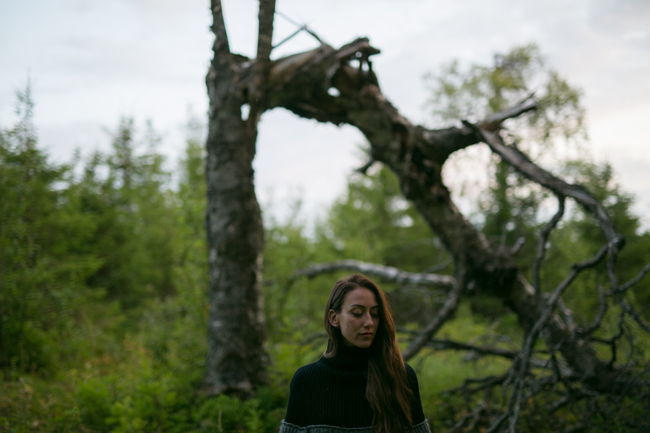
Anna Ķirse
I had a wonderful time in the Finnish forest on August 17 and 18. The fresh air, good food, pristine forest, invigorating walks and other aspects were a great detox from urban life, and I was honoured to be present at such an unusual co-production involving Latvian artists. But restless thoughts about the fragility of even the oldest forests and about how belated our “return” to nature really is are perhaps the most valuable lessons I’ve brought back home. But these thoughts are restless only from my own perspective and that of those close to me and our descendants. From the perspective of the Universe, it’s just a small detail. That is what the playful leaves, portrayed by sopranos Agate Pooka and Inga Martinsone, sing about in the finale of Windthrows: Semper idem// Semper idem// Calda otiosa lux fluet// Calor umbram liquescat (Always the same// Always the same// A warm, languid light flows// A heat that melts the shade).